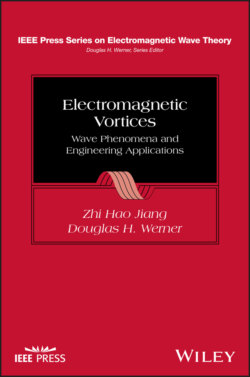Читать книгу Electromagnetic Vortices - Группа авторов - Страница 24
1.5 Summary and Perspectives
ОглавлениеThis chapter has provided a comprehensive overview of OAM beams. We analyzed the fundamental properties of OAM beams and contrasted them with conventional beams. In addition, an appendix is provided to summarize the fundamental mathematical details when the OAM concept is used for potential antenna applications. We discussed emerging applications of OAM in free‐space optical and RF communications as well as in fiber communications, highlighting potentials, and technical challenges. A comprehensive list of relevant references is included. We also summarized the generation methods of optical and RF OAM. Analogies regarding the fundamental properties, antenna communication links, and generation methods between OAM and conventional beams have been provided. More details on various aspects of OAM are discussed in various chapters of this book. We conclude by providing Table 1.2, which summarizes the theoretical and experimental milestones regarding OAM in chronological order. OAM is a field with short history of less than 30 years that has come a long way so far, and we are excited to see the future advancements of OAM.
Table 1.1 OAM generation methods and fabricated prototypes.
| Generation method | Prototype photo | |
|---|---|---|
| Spiral phase plate (SPP) Refs.: [13, 19,89–91] Optical and RF OAM | Photo credit: [90] | |
| Helicoidal reflector antenna and reflector antenna systems Refs. [23,92–94] RF OAM | Photo credit: [23] | |
| Planar spiral phase plate and transmitarray antenna Refs. [95–100] RF OAM | Photo credit: [95] | |
| Stepped spiral reflecting surface Ref. [101] RF OAM | Photo credit: [101] | |
| Uniform circular array (UCA) Refs. [33, 62,102–109] RF OAM | Photo credit: [102] | |
| Holographic gratings Refs. [110–113] Optical and RF OAM | Photo credit: [110] | |
| Reflectarray antennas Refs. [5,114–117] RF OAM | Photo credit: [114] |
